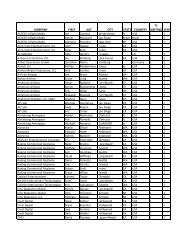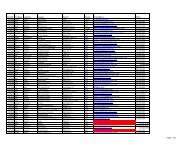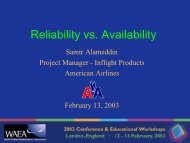Brian Roland
Brian Roland
Brian Roland
Create successful ePaper yourself
Turn your PDF publications into a flip-book with our unique Google optimized e-Paper software.
A Reality about Reliability<br />
<strong>Brian</strong> <strong>Roland</strong><br />
Project Manager, Interiors Engineering<br />
Continental Airlines<br />
February 13, 2003
A Reality about Reliability<br />
US airlines are required to have a<br />
Reliability Program in accordance to FAR<br />
121.373:<br />
Continuing Analysis and Surveillance.<br />
(a) Each certificate holder shall establish and maintain<br />
a system for the continuing analysis and surveillance of<br />
the performance and effectiveness of its inspection<br />
program and the program covering other maintenance,<br />
preventive maintenance, and alterations and for the<br />
correction of any deficiency in those programs….
Reliability versus Availability<br />
• Reliability<br />
– Useful in evaluating component performance<br />
and maintenance requirements<br />
• Availability (ARINC 628 Part 8)<br />
– Useful for evaluating a systems effectiveness at<br />
providing the intended service to the passenger
What is Reliability?<br />
By technical definition:<br />
The probability that an item will perform a<br />
required function without failure under<br />
stated conditions for a stated period of time
Operational Indicators<br />
• Inverse of failure rate (failures/hour)<br />
• MTBUR - Mean Time Between Unscheduled<br />
Removals<br />
– Total hours / number of unscheduled removals<br />
– Removal is an interruption of continual usage<br />
• MTBF - Mean Time Between Failure<br />
– Confirmed failure
Longevity Indicators<br />
• MTTF - Mean Time To Failure<br />
– Average time a unit remains serviceable until<br />
failure
IFE Reliability<br />
• Focus is on IFE components rather than<br />
entire system performance<br />
– Does the component work and for how long?<br />
• IFE is made up of components chained in a<br />
series - any break in the chain can be critical
Reliability over Availability<br />
• At Continental, availability is rarely used to<br />
measure IFE performance<br />
• Even with poor component reliability,<br />
availability can be 100%
Example<br />
Scenario for Tape Player<br />
Time span<br />
30 days<br />
Fleet size<br />
71 aircraft<br />
Number of units/aircraft 3<br />
Number of unscheduled removals 39
Calculating Usage<br />
Aircraft Utilization 3 flight-segments per day<br />
4 hours per segment<br />
Usage<br />
= 71 aircraft X 3 flight-segments/day X 30 days<br />
= 6390 aircraft flight-segments<br />
X 3 components/aircraft<br />
= 19,170 component flight-segments<br />
X 4 hours per segment<br />
= 76,680 component flight-hours
MTBUR Result<br />
• In terms of Reliability for 30-day period:<br />
MTBUR =<br />
76,680 component flight-hours<br />
39 unscheduled removals<br />
= 1966 Hours<br />
• MTBF Target is 4500 hours
But in Terms of Availability…<br />
• Result = 100% because of redundancies<br />
• Source Availability (ARINC 628P8)<br />
“Sources are only to be considered unavailable<br />
if a failure impacts the ability of a passenger to<br />
use the IFE system for its intended function.”
Availability Flying at 100%<br />
• Redundant components<br />
• Alternate programming<br />
• Manual play overriding automatic mode<br />
• Open seats with operative in-seat IFE
The Burdens of Breakdowns<br />
• Disruption and/or degradation of inflight<br />
service<br />
• Intervention required by flight crews<br />
• Maintenance costs and spares<br />
• Delays<br />
• Loss of revenue and loyalty<br />
• Customer compensation
IFE Reliability Management<br />
Concerted effort between Supplier and Airline<br />
– Maintenance reporting failures<br />
– Reliability analyzing failure modes and trends<br />
– Engineering determining root causes and<br />
implementing corrective action plans<br />
– Purchasing coordinating repair and action plan
Collecting Reliability Data<br />
Failure reporting is key:<br />
– Aircraft log pages and data collection<br />
• Details of conditions experienced is critical<br />
– Component tear down reports<br />
– Communication between supplier and airline
Measuring Reliability<br />
Invokes various statistical data analysis to<br />
assemble a proper perspective of reliability<br />
– Trend analysis<br />
– Growth analysis<br />
– Failure mode analysis<br />
– Times-to-failure analysis
IFE Problem Children<br />
• Tape Player<br />
• Monitor<br />
• Passenger Control Unit (PCU)<br />
• System Control Unit (SCU)<br />
• Audio
Log Page Analysis<br />
120<br />
737 NG IFE Log Pages<br />
30%<br />
100<br />
# L/P, (737NG, TTL 480)<br />
25%<br />
Nbr of Log Pages<br />
80<br />
60<br />
40<br />
% L/P (737NG)<br />
20%<br />
15%<br />
10%<br />
Percentage of Log<br />
Pages<br />
20<br />
5%<br />
0<br />
TAPE PLR MONITOR SCU PCU SEB PRAM ARU MUX<br />
# L/P, (737NG, TTL 480) 119 98 69 95 22 9 8 5<br />
% L/P (737NG) 25% 20% 14% 20% 5% 2% 2% 1%<br />
Category<br />
0%
Trend Analysis<br />
737NG TAPE PLAYER<br />
MTBUR or MTBF, Hours<br />
20000<br />
18000<br />
16000<br />
14000<br />
12000<br />
10000<br />
8000<br />
6000<br />
4000<br />
2000<br />
0<br />
12 month MTBF<br />
12 month MTBUR<br />
12 month NTF %<br />
100<br />
80<br />
60<br />
40<br />
20<br />
0<br />
5/99<br />
7/99<br />
9/99<br />
11/99<br />
1/00<br />
3/00<br />
5/00<br />
7/00<br />
9/00<br />
11/00<br />
01/01<br />
03/01<br />
05/01<br />
07/01<br />
09/01<br />
11/01<br />
01/02<br />
03/02<br />
05/02<br />
07/02<br />
09/02<br />
11/02<br />
NFF, %
Failure Mode Analysis<br />
50%<br />
Tape Player Failure Type Comparison<br />
Percent of Failures<br />
45%<br />
40%<br />
35%<br />
30%<br />
25%<br />
20%<br />
15%<br />
10%<br />
5%<br />
06-12/00 01-05/01<br />
0%<br />
INOP TAPE STUCK DAMAGE TAPES BAD PICTURE<br />
06-12/00 41% 20% 6% 5%<br />
01-05/01 32% 32% 13% 4%<br />
Failure Type
Typical Tape Path in Player
Demise of the Hi-8:<br />
Repair Breakdown<br />
NFF/Cln (10 REP ORDERS)<br />
REMOVE BAD TAPE (29)<br />
Tear Down N/A (13)<br />
Cassette Components Related (69)<br />
Eating Tape / Tape Stuck in / Tape Jam<br />
NFF/Cln (10 REP<br />
ORDERS)<br />
8%<br />
REMOVE BAD TAPE (29)<br />
24%<br />
Cassette Components<br />
Related (69)<br />
57%<br />
Tear Down N/A (13)<br />
11%
Failure Analysis Summary<br />
• Determine the root cause of failure/removal<br />
• Analyze repair breakdowns<br />
• Develop fault tree<br />
• Identify failure trends<br />
– Mechanical wear, deterioration, damage<br />
– Software fault<br />
– Environment – heat, humidity, contaminants
The VCC Environment
Improving IFE Reliability<br />
• Identify root cause of failures and implement fix<br />
• Increase spares and allocation<br />
• Modify software and/or hardware<br />
• Implement proper maintenance & equipment<br />
cleaning programs<br />
• Train personnel on better handling<br />
• Improve environment around IFE equipment
A Reality about Reliability<br />
• Reliability is a valuable measurement of IFE<br />
performance<br />
– Requires detailed failure reporting, complex data<br />
analysis, and an effective corrective action program<br />
• Redundancies allow availability to run at 100%<br />
• Design better “fly-to-fail” components while<br />
keeping cost of ownership down
THANKS!!















